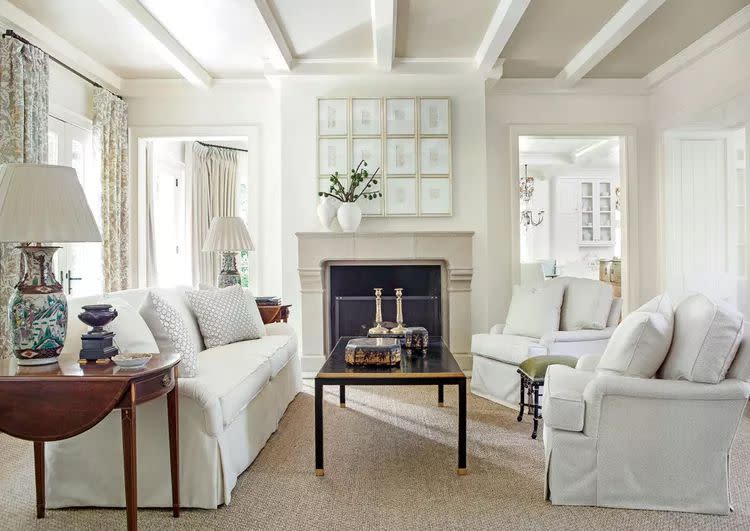Everything You Need To Know About Carpet Textures And Styles
Like why it might just be better than hardwood.

LAUREY W. GLENN
The trends may be swaying toward hard surfaces these days, but you may want to reconsider the underdog, carpet. “It was once considered the most luxurious, high end floor coverage,” Christine Slaughter, National Director of Design and Marketing for Shaw Builder + Multifamily at Shaw Floors says. “That’s why during renovations, you’ll often find hardwood underneath.” The benefits are endless. "Carpet acts as an acoustical barrier, and is softer underfoot, she says” There’s also a misconception that carpet is bad for asthma and allergies, but it’s actually the opposite. According to Slaughter, carpet grabs and protects those allergens until you can vacuum them up. "When you walk across a hard surface, you’re simply dusting them up before they fall back again on the floor,” she explains. Plus, playing with different carpet loops and patterns can add a tremendous amount of design value to your home while remaining timeless.
Christine Slaughter is the National Director of Design and Marketing for Shaw Builder + Multifamily at Shaw Floors.
There’s a lot of options on the market these days, and if you’re feeling overwhelmed, start your search with our in-depth guide to carpet textures.
Carpet Materials
Wool and olefin used to be two of the most major carpet materials, but then polyester and nylon came along. For a while, nylon was thought of as more durable than polyester, but years of engineering have now put them on equal footing. “Polyester is inherently more stain resistant than nylon, while nylon is more soil resistant than polyester,” Slaughter states.
Quality and Performance
“I truly believe you get what you pay for,” Slaughter declares. Performance ratings, engineering, the amount of twists in the yarn, and more all play a role in carpet quality. “You can’t look at one factor—it’s a combination of all of them,” she continues. Warranties matter as well. You may be concerned about installing carpet if you have a pet, but nowadays a tremendous amount of warranties cover pet issues, indicating the confidence they have in their fibers.
How to Care for Carpet
Slaughter’s best advice for taking care of your carpet? Something you do anyway: vacuum regularly. “You should be vacuuming your carpet as many times per week for as many people and pets that live in your home.” If you have four people and one pet, that means you should be vacuuming five times a week to help maintain the integrity and appearance. (Deep cleaning is also important.)
Carpet Textures

Illustration by Grace Canaan
Cut
A cut pile is one of the most traditional kinds of carpets. “The carpet is actually tufted into a loop into the primary backing, then goes through a shearing process where those loops are cut off so you have an unfinished look,” Slaughter illustrates. The higher pile height used to be more popular, but is now being traded in for a more tailored, tighter look.
Loop (AKA Berber)
Confused? Let Slaughter explain. “A lot of people will refer to loop carpets as Berber, and that’s actually a misnomer,” she says. “Berber, which is named after a North African tribe, has to do with the flecks of color in the carpet.” On the other hand, a loop pile is made with short, thick loops that together create a tightly wound pile.
Level Cut Loop
Introducing small scale patterns that don’t have an obvious timestamp on them has been on the rise for years. “When buyers are selecting carpet, they want to show a little more personality because a lot of times, it’s only going in bedrooms,” shares Slaughter. To create these textual patterns such as diamonds and stripes, a mix of cut and loop piles are used.
Saxony
“It tends to be an extremely formal carpet, like the kind that was in your grandmother’s living room you were never allowed to go in,” Slaughter quips. Saxony is far more dense than other piles, and shows vacuum lines and footprints easily because of the twisted piles that stand straight up. As a result, even though it’s super soft, it’s not as popular nowadays and typically only seen in low-traffic areas.
Friezé
Friezé is like Saxony’s fraternal twin. It’s equally dense and soft, but the twisted piles go in multiple directions instead of standing straight up so you don’t have to worry about vacuum lines and footprints. Friezé is usually a lower pile, but can turn into shag if it’s long enough.
For more Southern Living news, make sure to sign up for our newsletter!
Read the original article on Southern Living.

